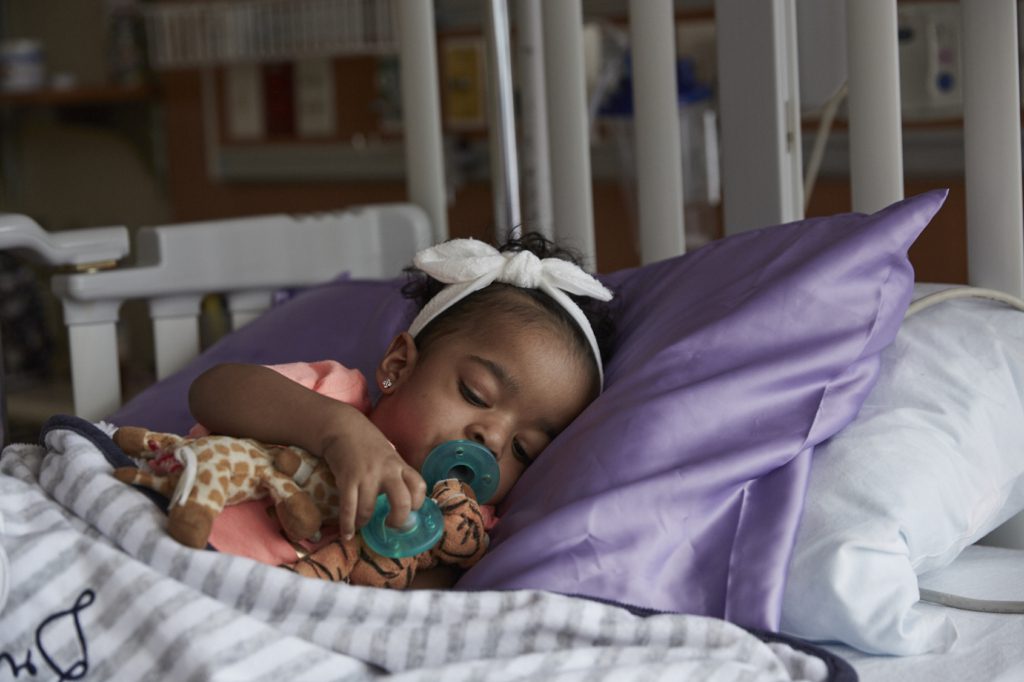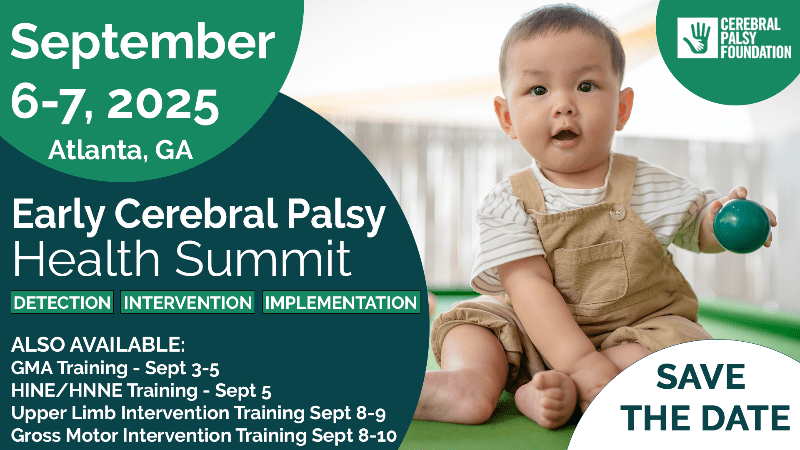
Early Detection & Intervention
EDUCATION AND TRAINING
The Cerebral Palsy Foundation is committed to creating a high standard for education and training as an element of our early detection & intervention network. We consistently provide opportunities for providers across disciplines to expand their knowledge base, gaining competency and confidence. We are committed to delivering the highest caliber of educational and training courses.
Early CP Health Summit
Planning is underway for the 2025 Early Cerebral Palsy Health Summit on September 6-7, to be held in Atlanta Georgia.
The 2025 Health Summit will share new pathways for translating knowledge into practice for the Implementation of early detection and intervention of cerebral palsy from the best researchers and clinicians in the field.
We will be offering in-person implementation workshops, a limited selection of in-person HINE, HNNE, GMA, and Intervention training at Emory University in Atlanta, GA.
We want you to SAVE THE DATE!

Cerebral Palsy Foundation training PROGRAMS
-
Early Detection Basic E-Course
-
HINE Training
-
GMA Training
-
Early Intervention Training Courses
The Basic Core eCourse is workshop series that will provide attendees with a structured outline on the implementation of best evidence for the early detection of infants at high risk of cerebral palsy. This course will offer basic implementation strategies, core knowledge of early detection principles and assessments, practical case examples and support to translate knowledge into practice for early detection of cerebral palsy at your own local sites.
This course is highly recommended for those who have not attended a past Implementation for Early Detection and Intervention of Cerebral Palsy Conference. It is open to all, but targeted to pediatric providers who want to improve outcomes for high risk infants through early cerebral palsy diagnosis and intervention in a multidisciplinary setting including: Pediatricians, Family Practitioners, Neonatologists, Neurologists, OTs, PTs. Business Managers, Nurse Practitioners, Researchers and Trainees.
Basic Core Course Workshops Include:
- Get the Basics on Detection Guideline Implementation Strategies and Tools
- Communicating a Diagnosis or Risk of CP
- Using the GMA and the HINE in Clinical Practice
- Motor Function Assessment for High Risk Infants
- Advances in Neuroimaging in the Detection of Cerebral Palsy
- Looking into the Future: Prognosis and Best Practices for Improved Long-Term Outcomes
- Communication and Language Assessments
- Early Motor Interventions to Improve Gross Motor Skills
- Neuroplasticity
- Brain Development and Congenital Brain Malformations
- Epilepsy and CP
Registration for 2025 coming soon
The Hammersmith Infant Neurological Examination (HINE), has been proposed as one of the early neurological examination tools for the diagnosis of CP. It is a simple and scorable method designed for evaluating infants between 2 months and 24 months of age. It includes 26 items that assess different aspects of neurological examinations such as cranial nerves, posture, movements, tone, and reflexes. The pro forma provides instructions for performing the individual items and diagrams to aid recording. The HINE is easily performed and accessible to all clinicians; it can be completed in 5 to 10 minutes. A good interobserver reliability has been reported, even in inexperienced staff.
The International Clinical Practice Guideline for the Early Accurate Diagnosis of Cerebral Palsy recommends the use of the HINE, particularly in situations where the most predictive tools general movements and MRI) are not able to be used. This training course will provide standardized training and all items in the HINE will be presented with the correct approach to administration and scoring. Infants aged between 6-24 months will be used to train the participants in small groups in accurate scoring of the HINE.
This training course is 4-hours long, including lecture, hands-on practical sessions, and Q&A discussions.
Recently Completed
-March 8 – Monterrey, Mexico
-March 22 – Oregon Health and Science University, Portland Oregon
-March 26 – Little Feet Therapy, DC
-March 29 – Unlimited Possibilities, Santa Ana, CA
-April 4 – UCP of Greater Cleveland, Ohio
We have over 20 trainers who have trained over 2000 clinicians in the U.S. and around the world. If you are interested in holding a HINE training at your facility please contact kandace.poindexter@yourcpf.org
Prechtl’s General Movement Assessment: Basic and Advanced Courses Research conducted in the last 20 years has shown that the qualitative assessment of spontaneous movement in the fetus, newborn, and young infant is an early and reliable indicator for diagnosis and prognosis of neurological disorders. Compelling evidence is now available that qualitative assessment of General Movements (GMs)—a specific type of spontaneous movement—under the age of five months is the best predictor of cerebral palsy. These courses fulfill the standards specified by the Generalized Movement Trust. (www.general-movements-trust.info)
These 3.5 day courses consist of lessons, demonstrations, and discussion of video-recordings. Lectures will alternate with exercises in small groups with videos prepared by the tutors. At the end of the course participants will be required to take a final test in order to receive a certificate of reliability in this method of assessment. Participants for the advanced course must have completed the basic training course prior to attending the advanced course. Advanced course participants will learn more detailed scoring
systems and will have the opportunity to review their own recordings with the tutor.
Learning Objectives
At the conclusion of this course, the participants will be able to:
Basic Course:
1. Assess typically developing infants using the Qualitative Assessment of General Movements
2. Assess infants with brain lesions using the Qualitative Assessment of General Movements
3. Describe how to incorporate the Qualitative Assessment of General Movements technique into their clinical and research practices
4. Distinguish between typical and atypical general movements in developing infants using the Qualitative Assessment of General Movements
Advanced Course
1. Assess the components of general movements including speed, amplitude, intensity, and rotations during the preterm and term age
2. Evaluate the individual trajectory of developing infants using the assessment of components of general movements
3. Assess fidgety movements and the concurrent motor repertoire (movements and postures) in 3-5 month old infants
4. Discuss their own diagnoses of developing infants using infant movement assessment illustrated with their own recordings
Upper Limb Intervention Therapy in Practice Course –
(Multi-Sensory, Constraint Induced Movement & Bimanual Therapy for Children with Cerebral Palsy 3 months to 3 years)
This two day workshop will allow participants to learn to apply and practice
best evidence protocols for bimanual and multimodal interventions that have been demonstrated to improve arm and hand function specifically for children with CP.
Participants will be trained in the science of the disorder and the mechanisms of the interventions, assessments to evaluate which protocol to use, delivery models, intervention exercises, the use of parent lesson plans and fidelity checks and self-monitoring. Workshops includes video and live demonstrations, skills checks, practice and self-assessments. Included in the course are manuals, a set of intervention materials and handouts.
Objectives:
1. Learn and compare best-evidence upper extremity protocols for children 0-3 with and at
high risk of cerebral palsy
2. Learn or refresh learning about the science of cerebral palsy and the mechanisms of the
interventions used in selected protocols
3. Identify and discuss assessments used to help determine appropriate protocols
4. Learn to use a parent-led intervention plan, including applying therapist as a coach
models, parent lesson plans, fidelity checks and self-monitoring
5. Practice applying protocols and discuss plan to implement protocols into practice